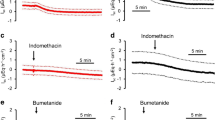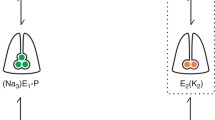Summary
Inhibition of the Na conductance of the apical membrane of the toad urinary bladder by amiloride, alkali cations and protons was voltage dependent. Bladders were bathed with a high K-sucrose serosal medium to reduce series basal-lateral resistance and potential difference. Transepithelial current-voltage relationships were measured over a voltage range of ±200 mV with a voltage ramp of frequency 0.5 to 1 Hz. Na channelI–V relationships were obtained by subtraction of currents measured in the presence of maximal doses of amiloride (10 to 20 μm). With submaximal doses of amiloride (0.05 to 0.5 μm), the degree of inhibition of the Na channel current (I Na) increased as the mucosal potential was made more positive. The data can be reasonably well explained by assuming that amiloride blocks Na transport by binding to a site which senses ∼12% of the transmembrane voltage difference.I Na was reduced in a qualitatively similar voltage-dependent manner by mucosal K, Rb, Cs and Tl (∼100mm) and by mucosal H (∼1mm). Block by these cations cannot be explained in terms of interactions with a single membrane-voltage-sensing site; a model in which there are two or more blocking sites in series provides a better description of the data. On the other hand, amiloride block was reduced competitively by mucosal Na and K, suggesting that occupation of the channel by one cation excludes occupancy by the others. ADH and ouabain also reduce the apparent affinity of amiloride for its blocking site. Thus, intracellular Na may also compete with amiloride for occupancy of the channel.
Similar content being viewed by others
References
Benos, D.J., Mandel, L., Balaban, R.S. 1979. On the mechanism of the amiloride-sodium entry site interaction in anuran skin epithelia.J. Gen. Physiol. 73:307–326
Benos, D.J., Mandel, L., Simon, S.A. 1980 Cation selectivity and competition at the sodium entry site in frog skin.J. Gen. Physiol. 76:233–247
Benos, J.D., Simon, S.A., Mandel, L.J., Cala, P. 1976. Effect of amiloride and some of its analogues on cation transport in isolated frog skin and thin lipid membranes.J. Gen. Physiol. 68:43–63
Bentley, P.J. 1968. Amiloride: A potent inhibitor of sodium transport across the toad bladder.J. Physiol. (London) 195:317–330
Cuthbert, A.W. 1976. Importance of guanidinium groups for blocking sodium channels in epithelia.Mol. Pharmacol. 12:945–957
Cuthbert, A.W., Shum, W.K. 1975. Effects of vasopressin and aldosterone on amiloride binding in toad bladder epithelial cell.Proc. R. Soc. London B 189:543–575
Cuthbert, A.W., Shum, W.K. 1977. Does intracellular sodium modify membrane permeability to sodium ions?Nature (London) 266:468–469
Eaton, D.C., Brodwick, M.S. 1980. Effects of barium on the potassium conductance of squid axon.J. Gen. Physiol. 75:727–750
Edmonds, D.T. 1982. Modelling the control mechanism of the Na channel in the apical membrane of tight epithelia.Proc. R. Soc. London B 217:111–115
Eisenman, G. 1962. Cation selective glass electrodes and their mode of operation.Biophys. J. 2:259–323
Erlij, D., Smith, M.W. 1973. Sodium uptake by frog skin and its modification by inhibitors of transepithelial Na transport.J. Physiol. (London) 228:221–239
Frankenhauser, B. 1960. Sodium permeability in toad nerve and in squid nerve.J. Physiol. (London) 152:159–166
Frazier, H.S., Dempsey, E.F., Leaf, A. 1962. Movement of sodium across the mucosal surface of the isolated toad bladder and its modification by vasopressin.J. Gen. Physiol. 45:529–543
French, R.J., Shoukimas, J.J. 1981 Blockage of squid axon potassium conductance by internal tetra-n-alkylammonium ions of various sizes.Biophys. J. 34:271–292
Fuchs, W., Hviid Larsen, E., Lindemann, B. 1977. Currentvoltage curve of sodium channels and concentration dependence of sodium permeability in frog skin.J. Physiol. (London) 267:137–166
Henrich, M., Lindemann, B. 1983. Voltage dependence of channel currents and channel densities in the apical membrane of toad urinary bladder.In Intestinal Absorption and Secretion. E. Skadhauge and K. Heintze, editors. MTP, Lancaster, England (in press)
Hille, B. 1975. Ionic selectivity of Na and K channels of nerve membranes.In: Membranes—A Series of Advances. G. Eisenman, editor. Vol. 3, Ch. 4. Marcel Dekker, New York
Latorre, R., Miller, C. 1983. Conduction and selectivity in potassium channels.J. Membrane Biol. 71:11–30
Leaf, A., Keller, A., Dempsey, E.F. 1964. Stimulation of sodium transport in toad bladder by acidification of the mucosal medium.Am. J. Physiol. 207:547–552
Li, J.H.-Y., Palmer, L.G., Edelman, I.S., Lindemann, B. 1982. The role of sodium-channel density in the natriferic response of the toad urinary bladder to an antidiuretic hormone.J. Membrane Biol. 64:77–89
Lindemann, B. 1982. Dependence of ion flow through channels on the density of fixed charges at the channel opening. Voltage control of inverse titration curves.Biophys. J. 39:15–22
Lindemann, B., Van Driessche, W. 1977. Sodium specific membrane channels of frog skin are pores: Current fluctuations reveal high turnover.Science 195:292–294
Palmer, L.G. 1982a. Na+ transport and flux ratio through apical Na+ channels in toad bladder.Nature (London) 297:688–690
Palmer, L.G. 1982b. Ion selectivity of the apical membrane Na channel in the toad urinary bladder.J. Membrane Biol. 67:91–98
Palmer, L.G., Edelman, I.S., Lindemann, B. 1980. Current-voltage analysis of apical sodium transport in toad urinary bladder: Effects of inhibitors of transport and metabolism.J. Membrane Biol.,57:59–71
Palmer, L.G., Lorenzen, M. 1983. Antidiuretic hormone-dependent membrane capacitance and water permeability in the toad urinary bladder.Am. J. Physiol. 244:F195-F204
Thomas, S.R., Suzuki, Y., Thompson, S.M., Schultz, S.G. 1983. The electrophysiology ofNecturus urinary bladder. I. “Instantaneous” current-voltage relations in the presence of varying mucosal sodium concentrations.J. Membrane Biol. 73:157–175
Thompson, S.M., Suzuki, Y., Schultz, S.G. 1982. The electrophysiology of rabbit descending colon: I. Instantaneous transepithelial current-voltage relations and the current-voltage relations of the Na-entry mechanism.J. Membrane Biol. 66:41–54
Turnheim, K., Frizzell, R.A., Schultz, S.G. 1978. Interaction between cell Na and the amiloride-sensitive sodium entry step in rabbit colon.J. Membrane Biol. 39:233–256
Van Driessche, W., Lindemann, B. 1979. Concentration dependence of currents through single sodium-selective pores in frog skin.Nature (London) 282:519–520.
Warncke, J., Lindemann, B. 1981. Effect of ADH on the capacitance of apical epithelial membranes.Adv. Physiol. Sci. 3:129–133
Woodhull, A.M., 1973. Ionic blockage of sodium channels.J. Gen. Physiol. 61:687–708
Author information
Authors and Affiliations
Rights and permissions
About this article
Cite this article
Palmer, L.G. Voltage-dependent block by amiloride and other monovalent cations of apical Na channels in the toad urinary bladder. J. Membrain Biol. 80, 153–165 (1984). https://doi.org/10.1007/BF01868771
Received:
Revised:
Issue Date:
DOI: https://doi.org/10.1007/BF01868771




